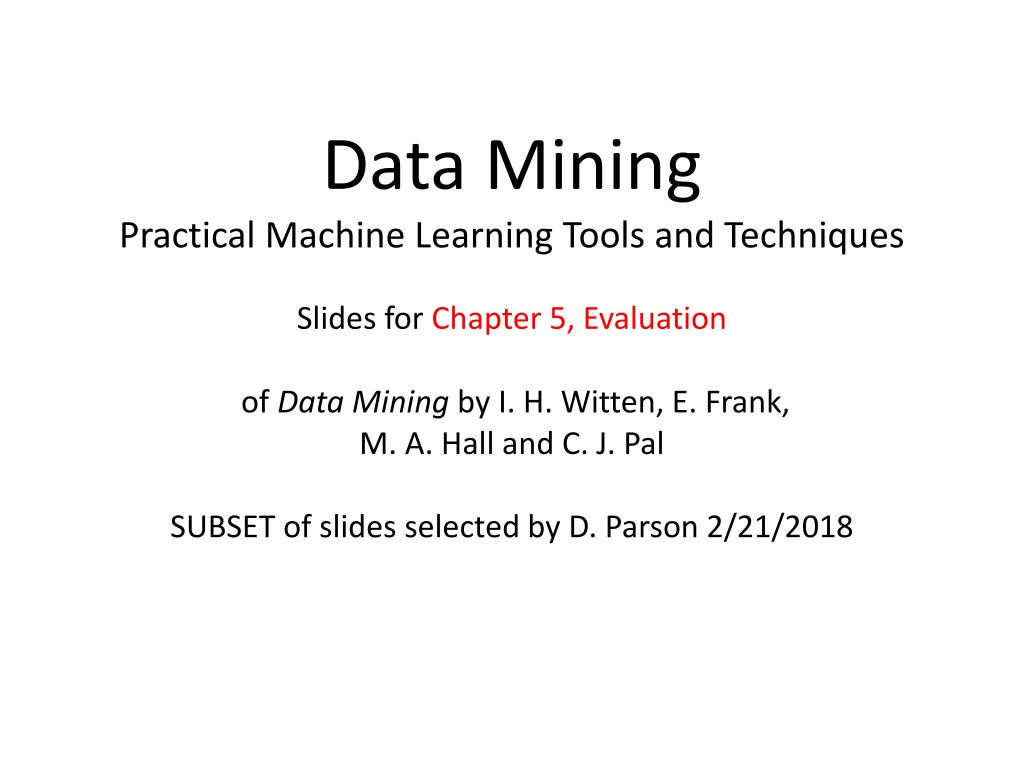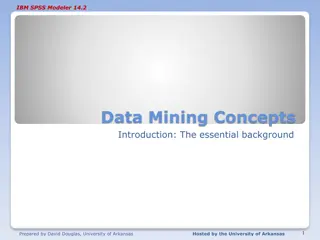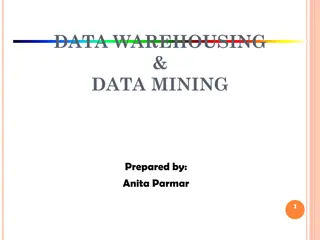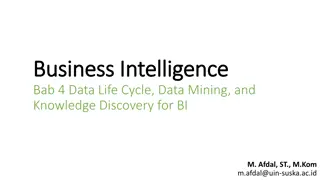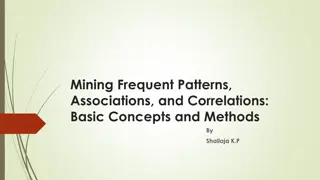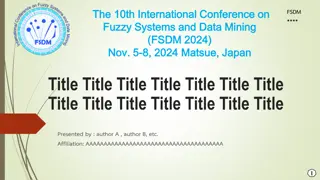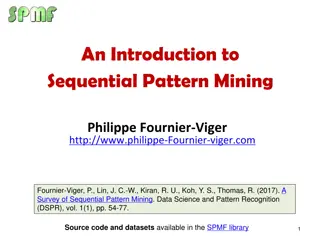Practical Data Mining Evaluation Techniques
Data mining evaluation is crucial for determining the predictive power of machine learning models. Issues such as training, testing, and tuning are explored, along with techniques like holdout, cross-validation, and hyperparameter selection. The evaluation process assesses model performance, statistical reliability, and the cost associated with errors. Key concepts include error rates, resubstitution errors, and the importance of using independent test sets for accurate performance estimation.
Download Presentation

Please find below an Image/Link to download the presentation.
The content on the website is provided AS IS for your information and personal use only. It may not be sold, licensed, or shared on other websites without obtaining consent from the author. Download presentation by click this link. If you encounter any issues during the download, it is possible that the publisher has removed the file from their server.
E N D
Presentation Transcript
Data Mining Practical Machine Learning Tools and Techniques Slides for Chapter 5, Evaluation of Data Mining by I. H. Witten, E. Frank, M. A. Hall and C. J. Pal SUBSET of slides selected by D. Parson 2/21/2018
Credibility: Evaluating whats been learned Issues: training, testing, tuning Predicting performance: confidence limits Holdout, cross-validation, bootstrap Hyperparameter selection Comparing machine learning schemes Predicting probabilities Cost-sensitive evaluation Evaluating numeric prediction The minimum description length principle Model selection using a validation set 2
Evaluation: the key to success How predictive is the model we have learned? Error on the training data is not a good indicator of performance on future data Otherwise 1-NN would be the optimum classifier! Simple solution that can be used if a large amount of (labeled) data is available: Split data into training and test set However: (labeled) data is usually limited More sophisticated techniques need to be used 3
Issues in evaluation Statistical reliability of estimated differences in performance ( significance tests) Choice of performance measure: Number of correct classifications Accuracy of probability estimates Error in numeric predictions Costs assigned to different types of errors Many practical applications involve costs 4
Training and testing I Natural performance measure for classification problems: error rate Success: instance s class is predicted correctly Error: instance s class is predicted incorrectly Error rate: proportion of errors made over the whole set of instances Resubstitution error: error rate obtained by evaluating model on training data Resubstitution error is (hopelessly) optimistic! 5
Training and testing II Test set: independent instances that have played no part in formation of classifier Assumption: both training data and test data are representative samples of the underlying problem Test and training data may differ in nature Example: classifiers built using customer data from two different towns A and B To estimate performance of classifier from town A in completely new town, test it on data from B 6
Note on parameter tuning It is important that the test data is not used in any way to create the classifier Some learning schemes operate in two stages: Stage 1: build the basic structure Stage 2: optimize parameter settings The test data cannot be used for parameter tuning! Proper procedure uses three sets: training data, validation data, and test data Validation data is used to optimize parameters 7
Cross-validation K-fold cross-validation avoids overlapping test sets First step: split data into k subsets of equal size Second step: use each subset in turn for testing, the remainder for training This means the learning algorithm is applied to k different training sets Often the subsets are stratified before the cross-validation is performed to yield stratified k-fold cross-validation The error estimates are averaged to yield an overall error estimate; also, standard deviation is often computed Alternatively, predictions and actual target values from the k folds are pooled to compute one estimate Does not yield an estimate of standard deviation 8
More on cross-validation Standard method for evaluation: stratified ten-fold cross- validation Why ten? Extensive experiments have shown that this is the best choice to get an accurate estimate There is also some theoretical evidence for this Stratification reduces the estimate s variance Even better: repeated stratified cross-validation E.g., ten-fold cross-validation is repeated ten times and results are averaged (reduces the variance) 9
Hyperparameter selection Hyperparameter: parameter that can be tuned to optimize the performance of a learning algorithm Different from basic parameter that is part of a model, such as a coefficient in a linear regression model Example hyperparameter: k in the k-nearest neighbour classifier We are not allowed to peek at the final test data to choose the value of this parameter Adjusting the hyperparameter to the test data will lead to optimistic performance estimates on this test data! Parameter tuning needs to be viewed as part of the learning algorithm and must be done using the training data only But how to get a useful estimate of performance for different parameter values so that we can choose a value? Answer: split the data into a smaller training set and a validation set (normally, the data is shuffled first) Build models using different values of k onthenew, smaller training set and evaluate them on the validation set Pick the best value of k and rebuild the model on the full original training set 10
Hyperparameters and cross-validation Note that k-fold cross-validation runs k different train-test evaluations The above parameter tuning process using validation sets must be applied separately to each of the k training sets! This means that, when hyperparameter tuning is applied, k different hyperparameter values may be selected This is OK: hyperparameter tuning is part of the learning process Cross-validation evaluates the quality of the learning process, not the quality of a particular model What to do when the training sets are very small, so that performance estimates on a validation set are unreliable? We can use nested cross-validation (expensive!) For each training set of the outer k-fold cross-validation, run inner p-fold cross-validations to choose the best hyperparameter value Outer cross-validation is used to estimate quality of learning process Inner cross-validations are used to choose hyperparameter values Inner cross-validations are part of the learning process! 11
Comparing machine learning schemes Frequent question: which of two learning schemes performs better? Note: this is domain dependent! Obvious way: compare 10-fold cross-validation estimates Generally sufficient in applications (we do not loose if the chosen method is not truly better) However, what about machine learning research? Need to show convincingly that a particular method works better in a particular domain from which data is taken 12
Comparing learning schemes II Want to show that scheme A is better than scheme B in a particular domain For a given amount of training data (i.e., data size) On average, across all possible training sets from that domain Let's assume we have an infinite amount of data from the domain Then, we can simply sample infinitely many dataset of a specified size obtain a cross-validation estimate on each dataset for each scheme check if the mean accuracy for scheme A is better than the mean accuracy for scheme B 13
Aside: the kappa statistic Two confusion matrices for a 3-class problem: actual predictor (left) vs. random predictor (right) Number of successes: sum of entries in diagonal (D) Kappa statistic: (success rate of actual predictor - success rate of random predictor) / (1 - success rate of random predictor) Measures relative improvement on random predictor: 1 means perfect accuracy, 0 means we are doing no better than random 14
Evaluating numeric prediction Same strategies: independent test set, cross-validation, significance tests, etc. Difference: error measures Actual target values: a1a2 an Predicted target values: p1p2 pn Most popular measure: mean-squared error Easy to manipulate mathematically 15
Other measures The root mean-squared error : The mean absolute error is less sensitive to outliers than the mean-squared error: Sometimes relative error values are more appropriate (e.g. 10% for an error of 50 when predicting 500) 16
Improvement on the mean How much does the scheme improve on simply predicting the average? The relative squared error is: The root relative squared error and the relative absolute error are: 17
Correlation coefficient Measures the statistical correlation between the predicted values and the actual values Scale independent, between 1 and +1 Good performance leads to large values! 18
Which measure? Best to look at all of them Often it doesn t matter Example: A B C D Root mean-squared error 67.8 91.7 63.3 57.4 Mean absolute error 41.3 38.5 33.4 29.2 Root rel squared error 42.2% 57.2% 39.4% 35.8% Relative absolute error 43.1% 40.1% 34.8% 30.4% Correlation coefficient 0.88 0.88 0.89 0.91 D best C second-best A, B arguable 19
The MDL principle MDL stands for minimum description length The description length is defined as: space required to describe a theory + space required to describe the theory s mistakes In our case the theory is the classifier and the mistakes are the errors on the training data Aim: we seek a classifier with minimal DL MDL principle is a model selection criterion Enables us to choose a classifier of an appropriate complexity to combat overfitting 20
Model selection criteria Model selection criteria attempt to find a good compromise between: The complexity of a model Its prediction accuracy on the training data Reasoning: a good model is a simple model that achieves high accuracy on the given data Also known as Occam s Razor : the best theory is the smallest one that describes all the facts William of Ockham, born in the village of Ockham in Surrey (England) about 1285, was the most influential philosopher of the 14th century and a controversial theologian. 21
Elegance vs. errors Theory 1: very simple, elegant theory that explains the data almost perfectly Theory 2: significantly more complex theory that reproduces the data without mistakes Theory 1 is probably preferable Classical example: Kepler s three laws on planetary motion Less accurate than Copernicus s latest refinement of the Ptolemaic theory of epicycles on the data available at the time 22
Using a validation set for model selection MDL principle is one example of a model selection criterion Model selection: finding the right model complexity Classic model selection problem in statistics: Finding the subset of attributes to use in a linear regression model (yes, linear regression can overfit!) Other model selection problems: choosing the size of a decision tree or artificial neural network Many model selection criteria exist, based on a variety of theoretical assumptions Simple model selection approach: use a validation set Use the model complexity that yields best performance on the validation set Alternative approach when data is scarce: internal cross- validation 23
Data Mining Practical Machine Learning Tools and Techniques Slides for Chapter 8, Data transformations of Data Mining by I. H. Witten, E. Frank, M. A. Hall, and C. J. Pal SUBSET of slides selected by D. Parson 2/21/2018
Data transformations Attribute selection: Scheme-independent and scheme-specific Attribute discretization: Unsupervised, supervised, error- vs entropy-based, converse of discretization Projections: principal component analysis (PCA), random projections, partial least-squares, independent component analysis (ICA), linear discriminant analysis (LDA), text, time series Sampling: Reservoir sampling Dirty data: Data cleansing, robust regression, anomaly detection Transforming multiple classes to binary ones error-correcting codes, ensembles of nested dichotomies Calibrating class probabilities 25
Just apply a learner? NO! Scheme/parameter selection Treat selection process as part of the learning process to avoid optimistic performance estimates Modifying the input: Data engineering to make learning possible or easier Modifying the output Converting multi-class problems into two-class ones Re-calibrating probability estimates 26
Attribute selection Attribute selection is often important in practice For example, adding a random (i.e., irrelevant) attribute can significantly degrade C4.5 s performance Problem: C4.5 s built-in attribute selection is based on smaller and smaller amounts of data Instance-based learning is particularly susceptible to irrelevant attributes Number of training instances required increases exponentially with number of irrelevant attributes Exception: na ve Bayes can cope well with irrelevant attributes Note that relevant attributes can also be harmful if they mislead the learning algorithm 27
Scheme-independent attribute selection Filter approach to attribute selection: assess attributes based on general characteristics of the data In this approach, the attributes are selected in a manner that is independent of the target machine learning scheme One method: find smallest subset of attributes that separates data Another method: use a fast learning scheme that is different from the target learning scheme to find relevant attributes E.g., use attributes selected by C4.5 and 1R, or coefficients of linear model, possibly applied recursively (recursive feature elimination) 28
Searching the attribute space Number of attribute subsets is exponential in the number of attributes Common greedy approaches: forward selection backward elimination More sophisticated strategies: Bidirectional search Best-first search: can find optimum solution Beam search: approximation to best-first search Genetic algorithms 29
Scheme-specific selection Wrapper approach to attribute selection: attributes are selected with target scheme in the loop Implement wrapper around learning scheme Evaluation criterion: cross-validation performance Time consuming in general greedy approach, k attributes k2 time prior ranking of attributes linear in k Can use significance test to stop cross-validation for a subset early if it is unlikely to win (race search) Can be used with forward, backward selection, prior ranking, or special- purpose schemata search Scheme-specific attribute selection is essential for learning decision tables Efficient for decision tables and Na ve Bayes 30
Attribute discretization Discretization can be useful even if a learning algorithm can be run on numeric attributes directly Avoids normality assumption in Na ve Bayes and clustering Examples of discretization we have already encountered: 1R: uses simple discretization scheme C4.5 performs local discretization Global discretization can be advantageous because it is based on more data Apply learner to k -valued discretized attribute or to k 1 binary attributes that code the cut points The latter approach often works better when learning decision trees or rule sets 31
Discretization: unsupervised Unsupervised discretization: determine intervals without knowing class labels When clustering, the only possible way! Two well-known strategies: Equal-interval binning Equal-frequency binning (also called histogram equalization) Unsupervised discretization is normally inferior to supervised schemes when applied in classification tasks But equal-frequency binning works well with na ve Bayes if the number of intervals is set to the square root of the size of dataset (proportional k-interval discretization) 32
Discretization: supervised Classic approach to supervised discretization is entropy-based This method builds a decision tree with pre-pruning on the attribute being discretized Uses entropy as splitting criterion Uses the minimum description length principle as the stopping criterion for pre-pruning Works well: still the state of the art To apply the minimum description length principle, the theory is the splitting point (can be coded in log2[N 1] bits) plus class distribution in each subset (a more involved expression) Description length is the number of bits needed for coding both the splitting point and the class distributions Compare description lengths before/after adding split 33
Supervised discretization: other methods Can replace top-down procedure by bottom-up method This bottom-up method has been applied in conjunction with the chi-squared test Continue to merge intervals until they become significantly different Can use dynamic programming to find optimum k-way split for given additive criterion Requires time quadratic in the number of instances But can be done in linear time if error rate is used instead of entropy However, using error rate is generally not a good idea when discretizing an attribute as we will see 34
The converse of discretization Make nominal values into numeric ones Can use indicator attributes (as in IB1) Makes no use of potential ordering information if nominal attribute is actually ordinal Alternative: code an ordered nominal attribute into binary ones as in M5 Inequalities are explicitly represented as binary attributes, e.g., temperature < hot in the weather data Can be used for any ordered attribute Better than coding ordering into an integer (which implies a metric) In general: can code binary partition of a set of attribute values as a binary attribute 35
Projections Simple transformations can often make a large difference in performance Example transformations (not necessarily for performance improvement): Difference of two date attributes Ratio of two numeric (ratio-scale) attributes Concatenating the values of nominal attributes Encoding cluster membership Adding noise to data Removing data randomly or selectively Obfuscating the data 36
Principal component analysis Unsupervised method for identifying the important directions in a dataset We can then rotate the data into the (reduced) coordinate system that is given by those directions PCA is a method for dimensionality reduction Algorithm: 1.Find direction (axis) of greatest variance 2.Find direction of greatest variance that is perpendicular to previous direction and repeat Implementation: find eigenvectors of the covariance matrix of the data Eigenvectors (sorted by eigenvalues) are the directions Mathematical details are covered in chapter on Probabilistic methods 37
Weka implementations Attribute selection CfsSubsetEval (correlation-based attribute subset evaluator) ConsistencySubsetEval (measures class consistency for a given set of attributes, in the consistencySubsetEval package) ClassifierSubsetEval (uses a classifier for evaluating subsets of attributes, in the classifierBasedAttributeSelection package) SVMAttributeEval (ranks attributes according to the magnitude of the coefficients learned by an SVM, in the SVMAttributeEval package) ReliefF (instance-based approach for ranking attributes) WrapperSubsetEval (uses a classifier plus cross-validation) GreedyStepwise (forward selection and backward elimination search) LinearForwardSelection (forward selection with a sliding window of attribute choices at each step of the search, in the linearForwardSelection package) BestFirst (search method that uses greedy hill-climbing with backtracking) RaceSearch (uses the race search methodology, in the raceSearch package) Ranker (ranks individual attributes according to their evaluation) 38
Weka implementations Learning decision tables: DecisionTable Discretization Discretize (unsupervised and supervised versions) PKIDiscretize (proportional k-interval discretization) Discriminant analysis for classification LDA, FLDA, and QDA (in the discriminantAnalysis package) Discriminant analysis for dimensionality reduction MultiClassFLDA (in the discriminantAnalysis package) PrincipalComponents and RandomProjection FastICA (independent component analysis, in the StudentFilters package) StringToWordVector (text to attribute vectors) PLSFilter (partial least squares transformation) Resampling and reservoir sampling 39
Weka implementations OneClassClassifier Implements one-class classification using artificial data (available in the oneClassClassifier package) MultiClassClassifier Includes several ways of handling multiclass problems with two-class classifiers, including error-correcting output codes END Ensembles of nested dichotomies, in the ensemblesOfNestedDichotomies package Many other preprocessing tools are available: Arithmetic operations; time-series operations; obfuscation; generating cluster membership values; adding noise; various conversions between numeric, binary, and nominal attributes; and various data cleansing operations 40
